| Specifications Usage Tips | | Product Summary |
|---|
The Salli Sway is a more economical model of the premium Salli Swing model, the most freely moving split saddle seat chair offered on the market today. The Sway differs only in that it has a lighter seat frame, standard (as compared to premium) components, and only one color option.The rocking mechanism enables the seat to freely and continuously tilt or 'rock' on the left-right and front-back axis (and all angles in combination) in response to the movements of the user without any adjustments to the chair. This stimulates muscles in the abdominal and pelvic area, realizing benefits for the user similar to those which can be obtained through use of an exercise ball. It also adds to the mobility and metabolism of the lower back while still getting appropriate support from the split saddle seat design and maintaining the natural curvature of the spine. The width of the two halves of the saddle seat are fixed and cannot adjust but the design accommodates the body types of most individuals. If an individual has very muscular or thick thighs, or minimal soft tissue (i.e. slight frame and below average weight), they may want to consider the Salli SwingFit.Height adjustment of the gas spring lift is accomplished through a standard hand-controlled height adjustment lever. Available lift sizes and the corresponding heights they accommodate are as follows: Short (4'0" to 5'2"), Mid (5'1" to 6'1") and Tall (5'8" to 6'5"). The 5-star base and lift are in an attractive chrome finish. The total weight of the chair is 10 kg (22 lb), the seat is 7.5 kg (16.5 lb) and is available in either black leather or black polyurethane (synthetic leather). | | Ergonomic Benefits |
|---|
Core Strengthening The unique rocking mechanism on the Salli Sway strengthens the core of the user as it is able to adjust to every movement of the body, following the natural movements as the user leans and shifts. This free movement also ensures that the muscles are in constant action as they ensure the user remains completely stable on the saddle seat. This movement can also be employed to a greater extent to consciously exercise the core by having the user train themselves to actively shift and counterbalance throughout the course of the day. The level of resistance to movement can be adjusted to the personal preference of the user.
Freedom of Movement The design of the Salli Saddle Seats encourages the entire upper body to move more freely than a traditional chair. In the absence of side or back constraints users are able to freely lean, stretch, and arch as they wish. This freedom translates into improved back mobility as it remains in constant flex. The upward stance of this style of seat also increases alertness as the entire body becomes involved in the sitting experience.
Correct Spinal Alignment (Improved Posture) All Salli Saddle Seats are designed to restore the correct alignment of the spine . This is accomplished when the user's pelvis is tipped forward due to the 45° downward angle of the thighs. The forward tilt of the pelvis restores the natural "S-Curve" of the spine, positioning it where it can best provide the support necessary for the torso, neck and head. Traditional chair seats actually force the lumbar portion of the spine outward (creating a 'C-Curve'), exerting unnatural and unsupported stress on the soft tissue muscles and ligaments of the lower back. The improved alignment of the spine which the Salli Saddle Seats promote alleviates or removes that stress, reducing fatigue by enabling those tissues to relax and rest. The "swing" mechanism on the SWAY offers a greater degree of comfort as it permits the seat to follow the body as it moves. Salli Posture versus Traditional Seating Problem Posture.
Ability to Deviate from Upright Position Securely For users such as Dentists or Chiropractors the Salli Saddle Seats can provide a significant posture improvement over other types of seating. This is due to the anatomical position yielded by a correctly positioned saddle seat, angling the thigh downwards rather than directly in front of the user (i.e. 90°). The enables the practitioner to move significantly closer to the patient, hovering over them while maintaining a stable seating posture. This ability to 'move in' enables them to maintain a more upright posture which in turn reduces the strain on the lower back - an issue which is common in both of these groups or anyone else who performs forward or side-reaching tasks. The unique movement of the Sway makes this movement even more natural as the seat moves with the user, further extending the reach. It also enables them to exert greater force when necessary while at the same time reducing the effort required. The closer positioning also provides users with a greater degree of hand and finger control since the arms can be held closer in to the body in a more neutral position.
Reduced Potential for Lower Back Pain By positioning the spine in its naturally strongest and correctly aligned position the continuous tension and stress which traditional chairs place on the lumbar portion of the spine is relieved. Much back pain is a response generated by the soft tissues (muscles, ligaments, etc) to notify us that overuse, overstressing, or damage has been done. This is a natural response by the body in an effort to advise us that something needs to be addressed. Ligaments and muscles are not designed to be held in constant tension. Over time ligaments lose their resiliency and are unable to return to their natural length (much like a rubber band will lose its original proportions once it is repeatedly stretched or held in an extended position). This will result in a greater stress on the muscles which are now required to exert extra continuous effort in order to aid the ligaments in providing the necessary support. Associated with this extra stress, muscles will often respond with cramping and spasming, usually accompanied by pain.
Reduced "Overreach" A complaint commonly associated with traditional seating is that it is difficult to reach items positioned to the sides or front. Doing so requires a significant rotation forward or outward from the shoulder, often combined with a forward bend from the waist. This can be a cause for concern for two reasons. First, the extreme reaching of the arms and the high degree of rotation necessary to accomplish this can lead to the development of shoulder-related issues. Usually this is addressed by trying to adapt the work area to the user by bringing frequently used items and equipment closer. However, there is always a limitation to the comfort zone of the user so this is usually only partially effective as a solution. The second area of concern related to the overreach is that when items are out of reach users will attempt to extend the limited range of their arms by 'bending' or 'stretching' forward from the waist. This exerts unnatural and unnecessary stress on the lower back, increasing the potential for development of lower back pain. A Salli Saddle seat addresses both of these concerns by providing a significantly increased reaching zone. The forward tilt of the pelvis immediately provides several inches of additional forward reach that cannot be available when seated in a traditional chair as the upper body is brought into closer proximity to the work space. In combination with this is the fact that a saddle seat position permits the entire torso to accomplish the reach, rather than relying on a single joint such as the shoulder. By spreading the reaching movement throughout the upper body not only are users able to reduce the angle of the shoulder rotation but also the potential for stress on the lower back. The result of this is that the reach of an average user can easily and comfortably be extended 12" - 18" beyond what they could normally reach from a traditional chair.
Achieve Sit/Stand Benefits WITHOUT Standing: Due to the unique posture and active seating position which the Salli Sway offers, the user is able to realize many of the benefits attributed to an active standing posture without some of the accompanying concerns. The rocking motion of the seat can improve core muscle tone, posture is improved, blood flow is increased due to the greater degree of movement offered, and improved overall abdominal activity due to the open and upright stance ensures improved bloodflow and increased metabolism. This automatically results in a greater degree of alertness and the ability to better focus on the tasks at hand.
IMPORTANT NOTE Working in a Saddle Seat will generally require some modifications to the workstation. Since it elevates the torso of the user there will be a requirement to ensure that keyboard, mouse and monitor are all able to be brought into an appropriate height position in order to maintain a neutral posture for the hands, arms, and neck. For average or shorter users this might be able to be accomplished by elevating the desk using specialized lifters such as Raise-Its which can safely raise a desk by up to 3". Standard keyboard arms and trays may also provide enough elevation or may be utilized in combination with a product like the Raise-Its. The monitor mount may have enough range to elevate the screen to the desired greater height or a few simple monitor risers in combination with its integral movement may provide the necessary elevation. For more complex scenarios such as taller users it may be necessary to provide an elevating workstation that can be raised enough to bring these devices into the correct alignment. The advantage that a Saddle Seat offers over a Sit/Stand workstation is that the user is still in a seated position and the monitor and keyboard do not need to shift throughout the day as the range of motion and viewing angles do not change. In order to properly equip a true Sit/Stand Workstation it would need to accommodate the changes which occur when the user switches from Sitting to Standing. These include small but significant changes in the hand/arm positions and more significant changes in the viewing angle required for the monitor. This may often require a monitor arm with a fairly wide range of elevation adjustment, adding additional cost to the adaptation.
| | Features |
|---|
- Split Seat for Comfort: The patented 'Split Seat' design of the Salli Sway is designed to provide firm but comfortable support for virtually all adult users. The shape of the seat ensures that pressure is focused on the sitting bones rather than the thighs and buttocks. The split design provides a comfortable seat for both men and women and also offers a cooling effect that standard chairs or one-piece saddles cannot provide.
- Adjustable Height Options: Three different lift heights are availabe - enabling the Salli Sway to meet the seating heights of users ranging from 4' to 6'5" or over.
- Short fits 4'0" to 5'2",
- Mid fits 5'1" to 6'1"
- Tall fits 5'8" and over
- Adjustable Movement: The unique rocking motion which the Sway provides is able to be adjusted to the individual preferences of each user, enabling lesser or greater degrees of resistance.
- Quality Upholstery: Available upholstery options are:
- BlackSynthetic Leather (other colours by Special Order) - Durable polyurethane is disinfectable for medical use and meets California TB 133 flammability standards
- Black Genuine Leather
- Easy Rolling: Five 65mm hard floor casters hard floors) on the polished aluminum base enable users to use their feet in a push/pull motion to roll around a work area with minimal effort.
- Weight Rating: The Salli Sway is designed to safely support users up to 264 lbs (120kg). The Salli Strong is recommended for those exceeding this rating.
| | Images and Multimedia |
|---|
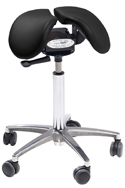
Salli Sway
| 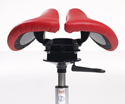
Salli Sway Showing Swing Mechanism
| 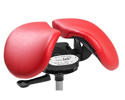
Salli Sway - Closeup of Seat
| 
Salli Swing Concept
| 
Swalli Sway Specifications
| 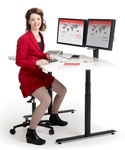
Salli Saddle Seat in Office
| 
Salli Saddle Seat in Dental Office
| 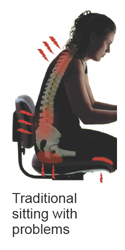
Traditional Seats Damage Posture
| 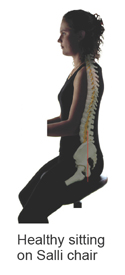
Salli Seats Improve Posture
|
| | Models |
|---|
| For related products, visit our online product listing. | | Model # | Description | TD Synnex SKU |
|---|
| SSCSY-L1-000 | Salli Sway with Black Leather Seat, fixed width divided seat, free moving tilt (front-to-back and side-to-side), medium pneumatic chrome lift, polished aluminum base, soft 65 mm casters, accommodates users up to 264 lbs (120 kg) | |
| | Accessories |
|---|
| Model # | Description |
|---|
| 440 | Salli Hard Caster Glide Accessory, converts Salli chair for stationary use, permits chair to glide when not loaded (Note: Price is for 1 unit, order 5 if you want a complete set for a Salli Chair). |
|
|